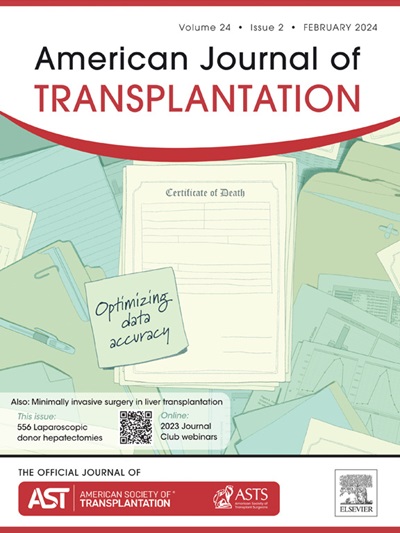Belatacept-related cytomegalovirus infection: Advocacy for tailored immunosuppression based on individual assessment of immune fitness
IF 8.2
2区 医学
Q1 SURGERY
引用次数: 0
Abstract
Belatacept, a fusion protein combining cytotoxic T-lymphocyte antigen-4 (CTLA-4) and the Fc region of human IgG1, is increasingly used as a calcineurin inhibitor–sparing regimen in patients with chronic graft dysfunction. Older kidney transplant recipients, particularly from expanded criteria donors, may be switched to belatacept due to poor renal recovery. However, late-onset cytomegalovirus (CMV) reactivation is increasingly reported with this treatment, especially in older patients with graft dysfunction. This suggests a progressive loss of CMV-specific T cell response, potentially driven by T cell exhaustion. Contributing factors include preexisting T cell dysfunction, increased viral antigen exposure, and interference in the PD-L1/PD-1 pathway by belatacept. mTOR inhibitors have shown efficacy in preventing CMV reactivation by reinvigorating CMV-specific T cells. These findings support combining belatacept with mTOR inhibitors in high-risk CMV-seropositive recipients and emphasize the need for personalized immune assessments to guide immunosuppressive strategies.
与贝拉替塞相关的巨细胞病毒感染:提倡根据个人免疫健康状况的评估采取有针对性的免疫抑制措施。
贝拉替塞(Belatacept)是一种结合了 CTLA-4 和人类 IgG1 Fc 区的融合蛋白,越来越多地被用作慢性移植物功能障碍患者的钙神经抑制剂备用方案。年龄较大的肾移植受者,尤其是来自扩大标准供体的肾移植受者,可能会因肾功能恢复不佳而改用贝拉他赛普。然而,越来越多的报告显示,在接受这种治疗时,尤其是在移植物功能障碍的老年患者中,会出现晚期 CMV 再激活的情况。这表明 CMV 特异性 T 细胞反应逐渐丧失,可能是 T 细胞衰竭所致。mTOR抑制剂已显示出通过重振CMV特异性T细胞来预防CMV再激活的疗效。这些研究结果支持在 CMV 血清阳性的高风险受者中将贝拉替塞与 mTOR 抑制剂联合使用,并强调了进行个性化免疫评估以指导免疫抑制策略的必要性。
本文章由计算机程序翻译,如有差异,请以英文原文为准。
求助全文
约1分钟内获得全文
求助全文
来源期刊
CiteScore
18.70
自引率
4.50%
发文量
346
审稿时长
26 days
期刊介绍:
The American Journal of Transplantation is a leading journal in the field of transplantation. It serves as a forum for debate and reassessment, an agent of change, and a major platform for promoting understanding, improving results, and advancing science. Published monthly, it provides an essential resource for researchers and clinicians worldwide.
The journal publishes original articles, case reports, invited reviews, letters to the editor, critical reviews, news features, consensus documents, and guidelines over 12 issues a year. It covers all major subject areas in transplantation, including thoracic (heart, lung), abdominal (kidney, liver, pancreas, islets), tissue and stem cell transplantation, organ and tissue donation and preservation, tissue injury, repair, inflammation, and aging, histocompatibility, drugs and pharmacology, graft survival, and prevention of graft dysfunction and failure. It also explores ethical and social issues in the field.

 求助内容:
求助内容: 应助结果提醒方式:
应助结果提醒方式:


